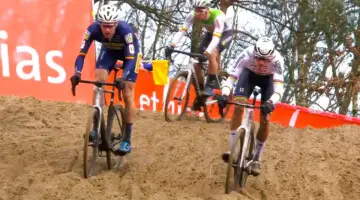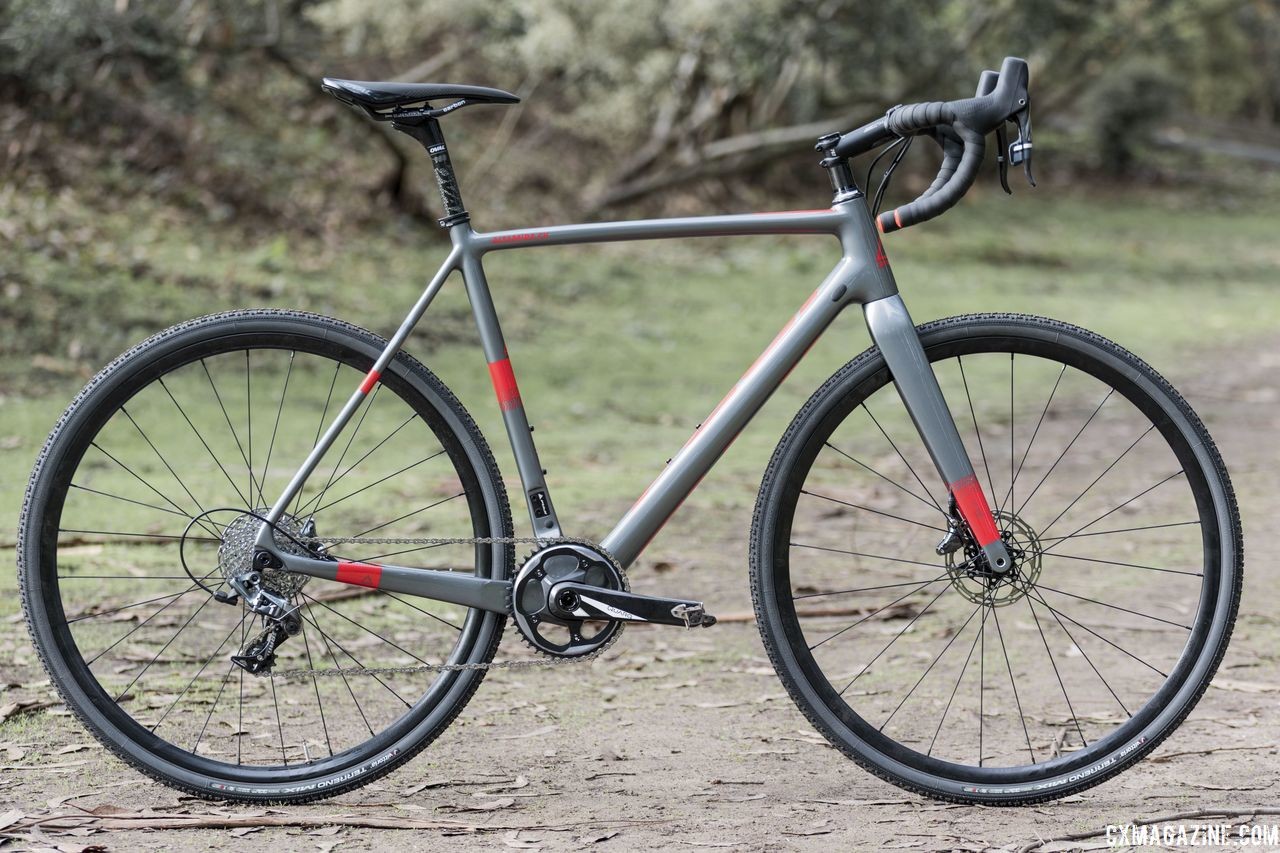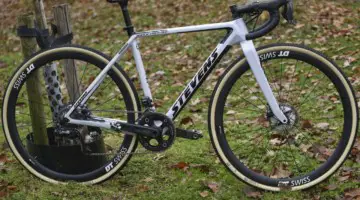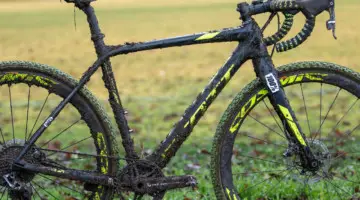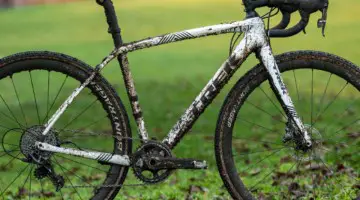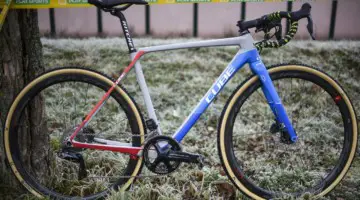There are many bike brands out there, but few have a history as long as Fuji.
In 1899, the Fuji brand was founded in Japan, and then half a century later, it came to these shores to establish Fuji America. At the time, it was one of the first non-European companies to be in the American bike market.
In the 1970s, Fuji boldly introduced Shimano’s new Dura-Ace top-end racing components to the international market with the Fuji Ace, putting both companies in the spotlight. Today Fuji is part of an international conglomerate whose parent company is presently going through a reorganization. The Fuji brand operates independent of the parent, and we will watch to see if the brand continues to thrive.
Fuji has a long history in U.S. professional cyclocross. Paul Curley rode a titanium Fuji in the 1990s, and then Mark McCormack rode its cyclocross bike and contributed to the design of the original Altamira nearly a decade ago.
Jonathan Page signed with Fuji prior to the 2014 season and rode an Altamira CX 1.1 up until the start of his last season as a cyclocross professional.
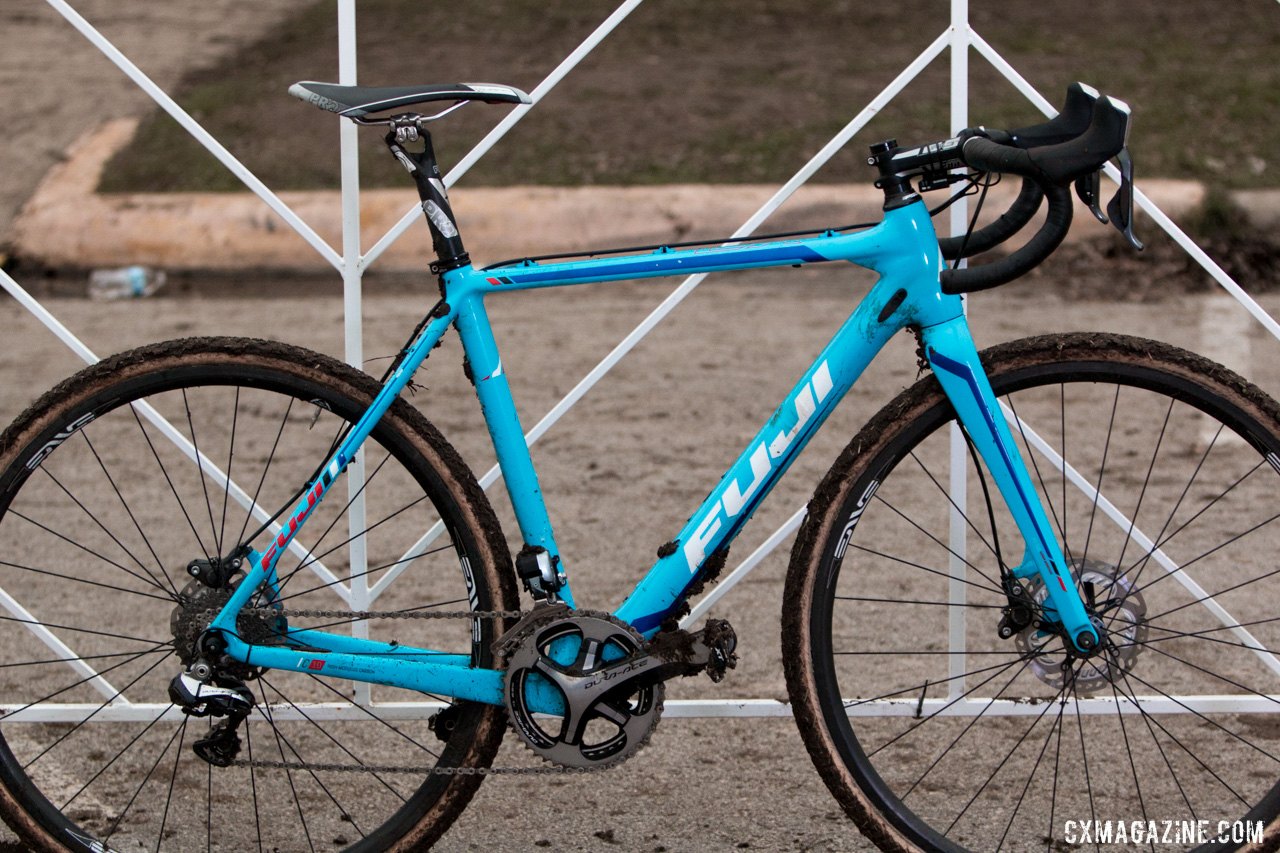
Jonathan Page rode a Fuji Altamira CX 1.1 at the 2015 Austin Cyclocross Nationals. © Cyclocross Magazine
Now, pilotship of the Altamira CX has shifted to another four-time national champion in Jeremy Powers, who counts Fuji as the bike sponsor of his new Pactimo-Fuji-SRAM program. With a McCormack as an influencer of the bike's design and two former American national champions riding the frameset, the current iteration of the Fuji Altamira CX 1.1 shows the bike's race-oriented pedigree.
We received a review sample of the top-end $4,000 2019 Altamira CX 1.1 carbon bike in the middle of the cyclocross season, so we had the chance to race it on various courses in a variety of conditions.
Would it have us riding like the JPs? Read on to find out.
The Frame
The Fuji Altamira CX 1.1 carbon frame uses Fuji’s second-tier C10 carbon fibers. The published weight of the frame is 950 grams, but we did not strip the bike to verify that. Our review sample is a size L, and although the published weights are often for smaller sizes, we can say that a Large-frame bike that tips the scales at just over 17 pounds fully equipped likely has a light skeleton.
In recent years, we have seen bikes such as the Specialized CruX and Trek Boone go in a race-specific direction with their designs. We first reviewed the Altamira CX 1.1 in 2013, and since then, Fuji has followed the race-specific trend by giving its latest Altamira CX 1.1 a frameset with a bit of traditional cyclocross geometry mixed with modern features.
The size L frame has a "square" measure of a 56cm effective top tube combined with a 56cm seat tube. The 145mm head tube has a traditional 72-degree angle, and the seat tube angle is 73.3 degrees.
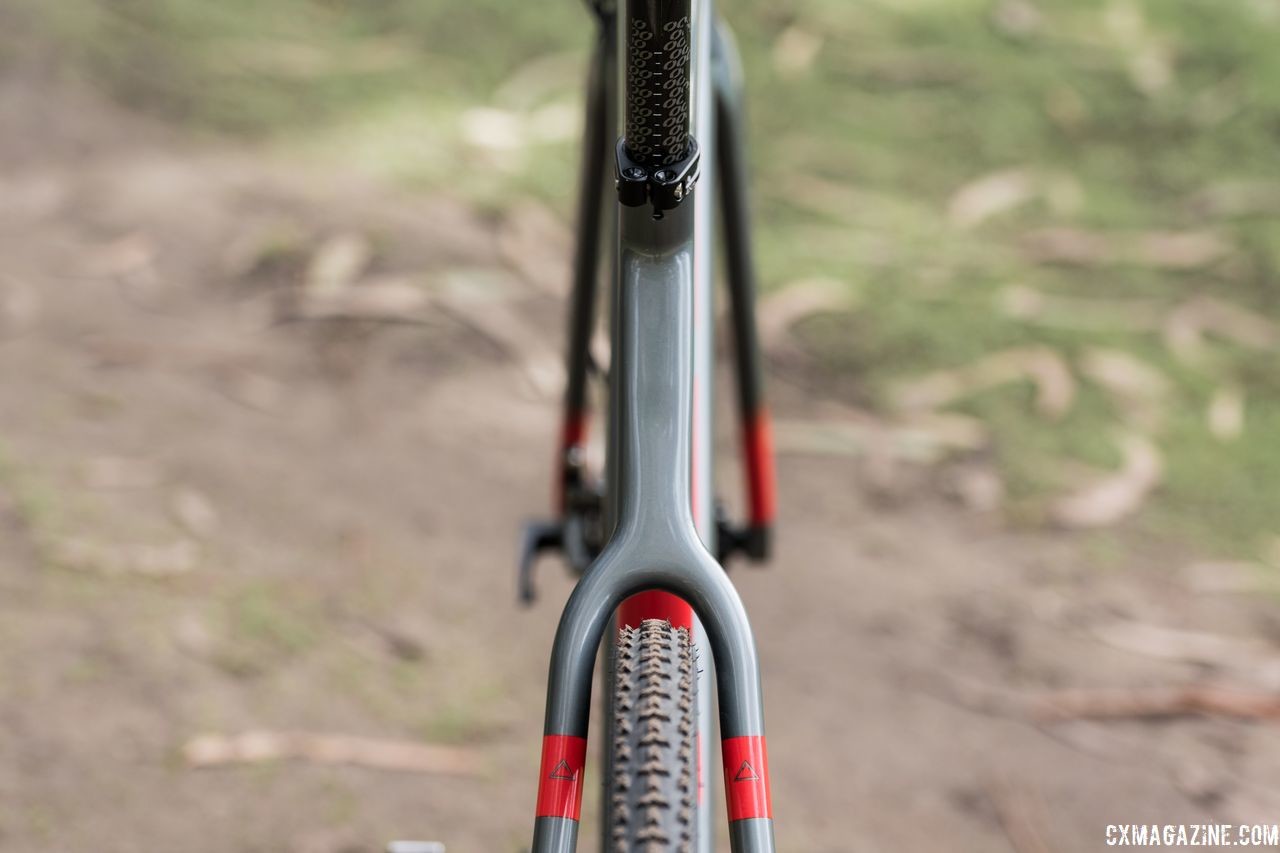
The Altamira is a race-specific bike, so the max claimed tire clearance is 35mm. Fuji Altamira CX 1.1 carbon cyclocross bike. © C. Lee / Cyclocross Magazine
The 42.5cm chainstays are a standard cyclocross bike parameter, as is the 102.6cm wheelbase. Notably, the 5.7cm bottom bracket drop is high, even compared to the old European standard of 6.0 to 6.2cm. Stack for the size L frame is 562mm, and the reach is 393mm.
The Altamira has modern touches such as flat mounts for the disc calipers with a 140mm minimum setting and internal control line routing.
The rear derailleur cable enters the top tube adjacent to the rear brake line but has a cable housing stop. The cable runs naked through the frame, across an open cable guide under the PF30 bottom bracket shell and through the chainstay before exiting the top just in front of the rear derailleur. This contributes to weight savings and arguably avoids housing compression, but it is curious since compressionless housing is common for shift cables.
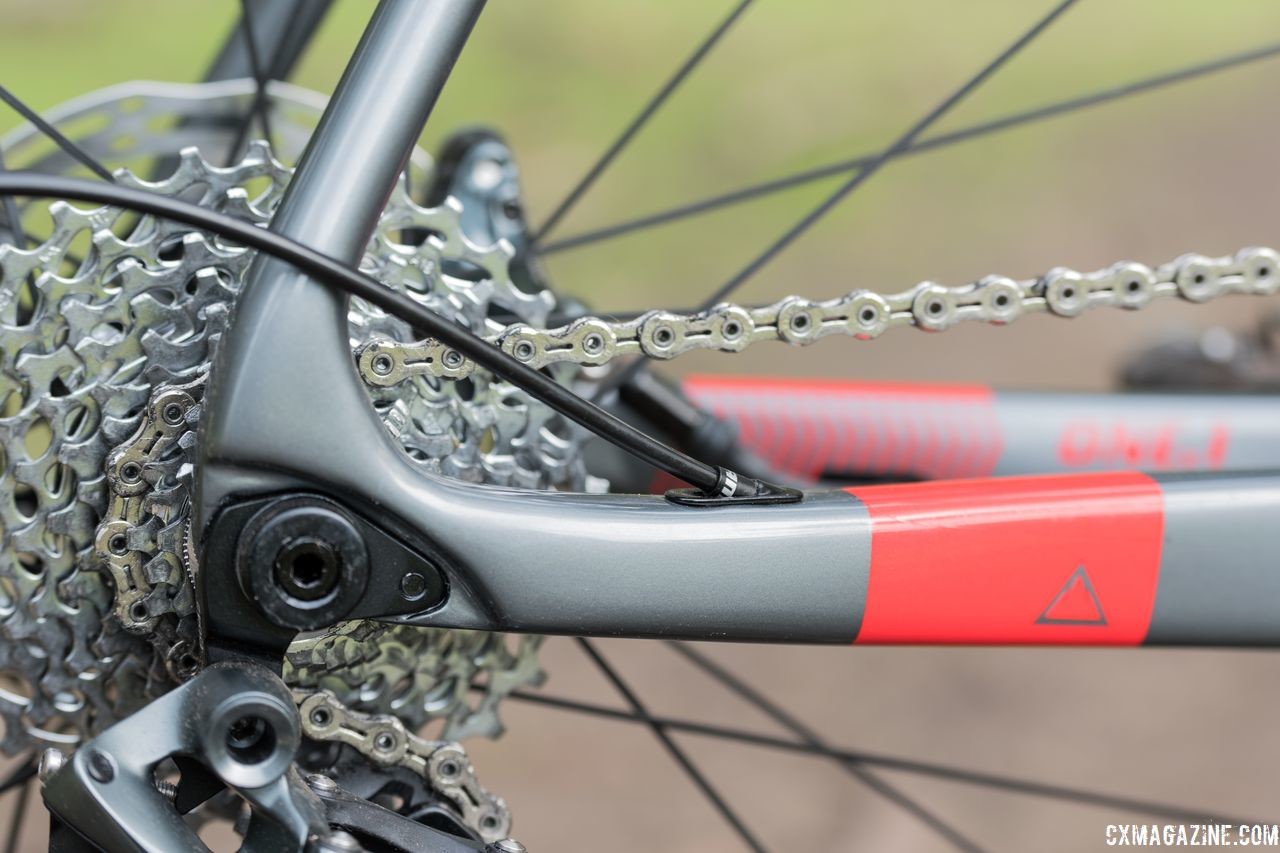
The chainstay features a rear derailleur cable stop, not a cable pass-through. Fuji Altamira CX 1.1 carbon cyclocross bike. © C. Lee / Cyclocross Magazine
There is a mounting plate for a front derailleur, though both models of the Altamira CX come with single-ring drivetrains, as we saw Jeremy Powers ride this season with the new SRAM RED 1 eTAP AXS groupset. If you opt for a dual-ring setup, the front derailleur cable would enter the downtube and run via full housing to a stop within the bottom bracket shell that also has a port for an electronic shift wire if you run a wired setup.
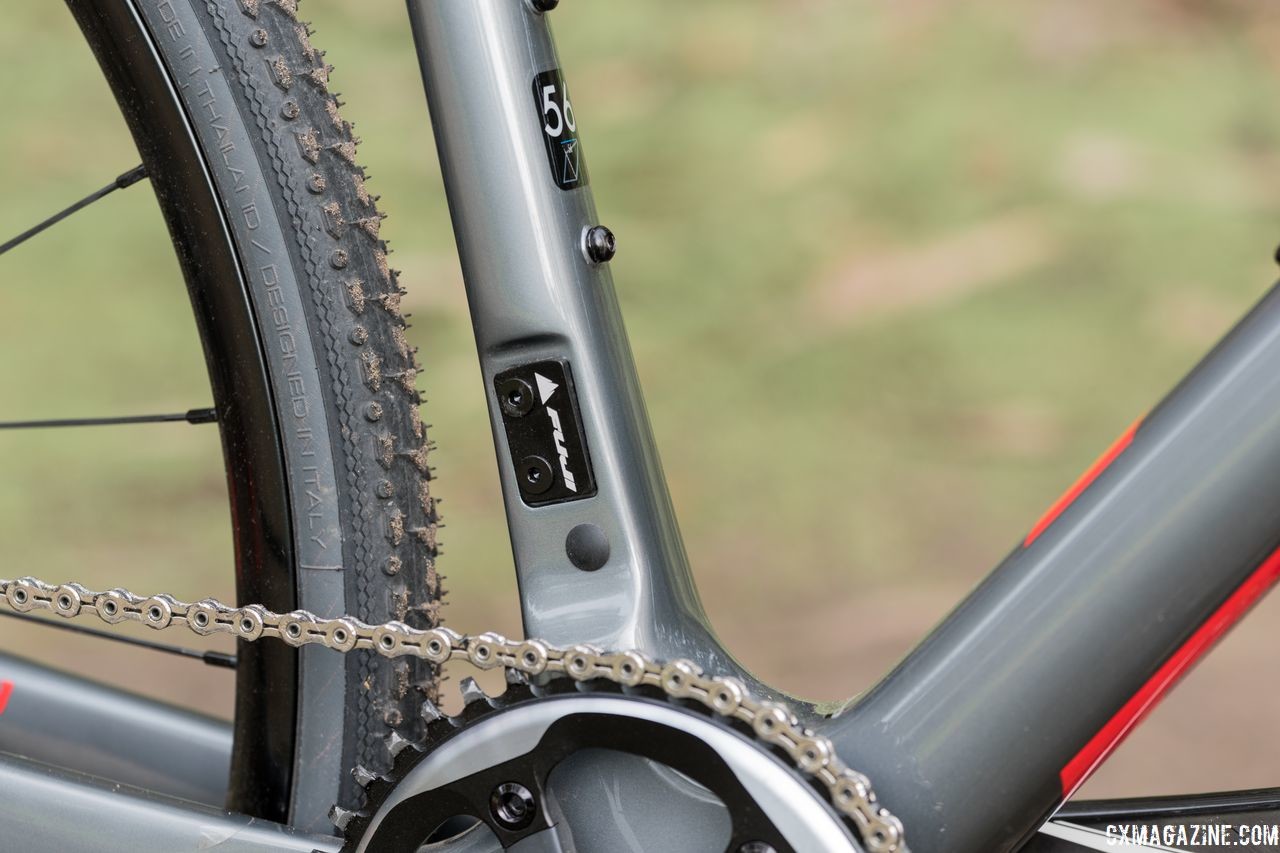
Although the Altamira CX comes 1x, it has a mount for a front derailleur. Fuji Altamira CX 1.1 carbon cyclocross bike. © C. Lee / Cyclocross Magazine
There are only mountings for two bottle cages in the usual down tube and seat tube spots; no rack or fender mounts. Tire clearance is for ’cross tires, with a 35mm max width, though certain 38mm tires will fit with a squeeze.
The fork is all carbon with a tapered steerer and an internal brake line to keep things neat. Interestingly the crown has a hole, but we’re unsure what you’d mount there, given the lack of fender stay mounts. The frameset is 12mm thru-axle front and rear.
The Build
Fuji purchased Oval Concepts several years ago, so it was not surprising to see a plethora of Oval Concepts components, mostly carbon, on the Fuji Altamira CX 1.1. The carbon components help the bike achieve its low curb weight.
The 910 Ergo carbon bar has a forward kink just lateral to the stem before it sweeps back four degrees along the top. The Oval Concepts stem is aluminum and 100mm on the size L bike we reviewed.
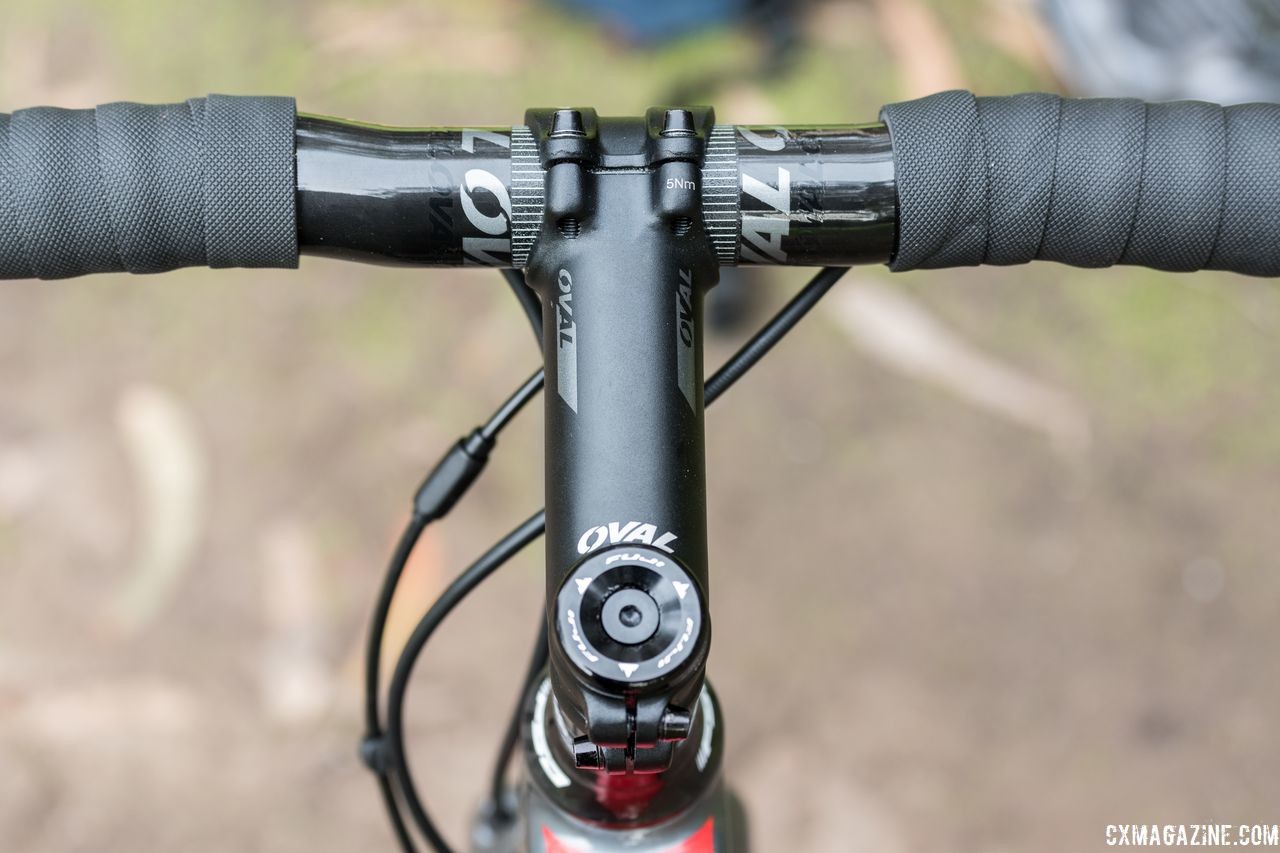
The Oval Concepts carbon bar has an interesting forward bend. Fuji Altamira CX 1.1 carbon cyclocross bike. © C. Lee / Cyclocross Magazine
The Oval Concepts 950 carbon seatpost is 27.2mm diameter with a two-bolt mount for the saddle, which offers the adjustability and security that we like a lot. The saddle is an Oval Concepts X38c with carbon rails.
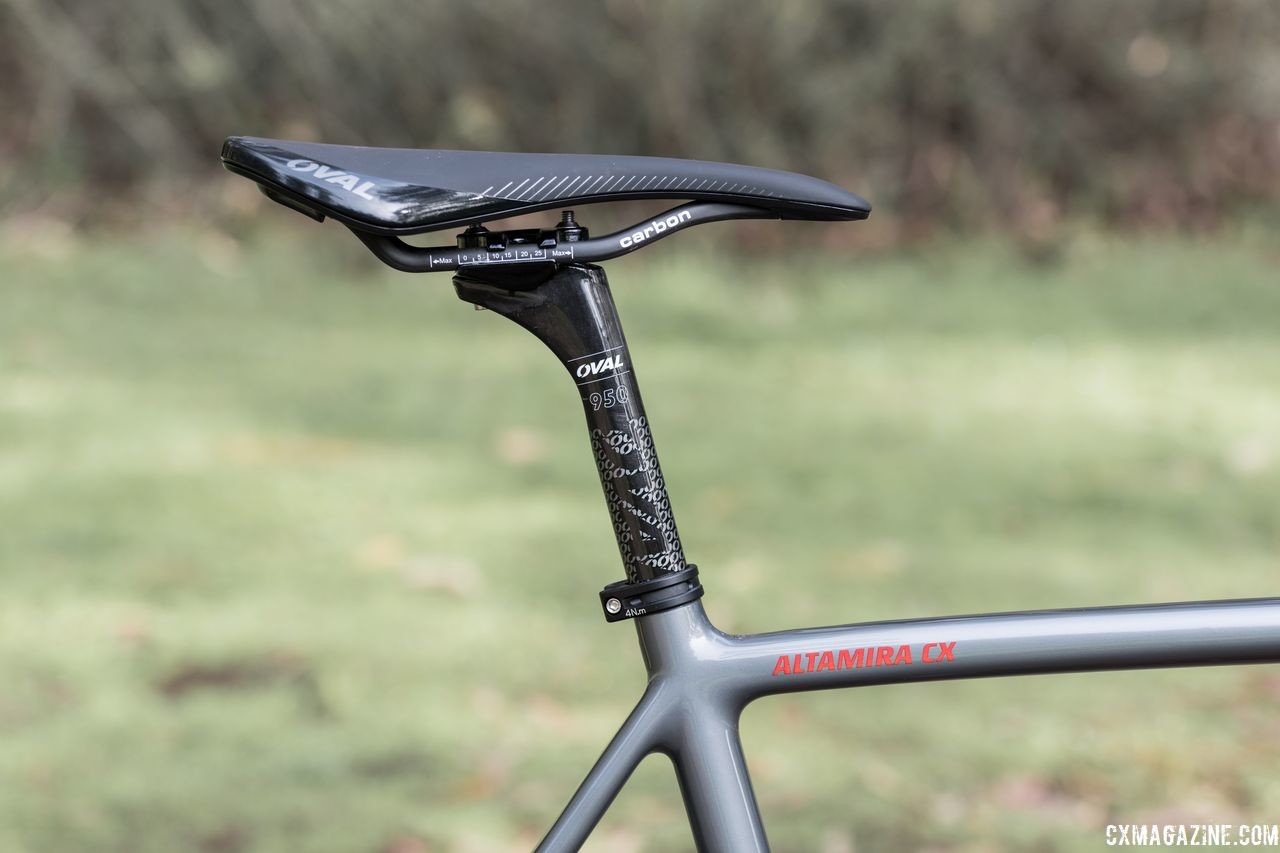
Oval Concepts carbon parts help lower the bike's weight. The seatpost is a carbon 950 and the X38c saddle has carbon rails. Fuji Altamira CX 1.1 carbon cyclocross bike. © C. Lee / Cyclocross Magazine
The drivetrain on our review bike is SRAM Force 1 HRD, though the crankset has Quarq branding and is ready for a Quarq DZero power meter. The front chain ring supplied is a SRAM X-Sync 42 tooth.
Combined with the SRAM PG-1070 11-speed cassette in an 11-32t spread, the Altamira CX 1.1 is race ready for the power output of one of the JP pros. Brake duties are via the Force hydraulic calipers applied to 140mm SRAM Centerline rounded CenterLock rotors.
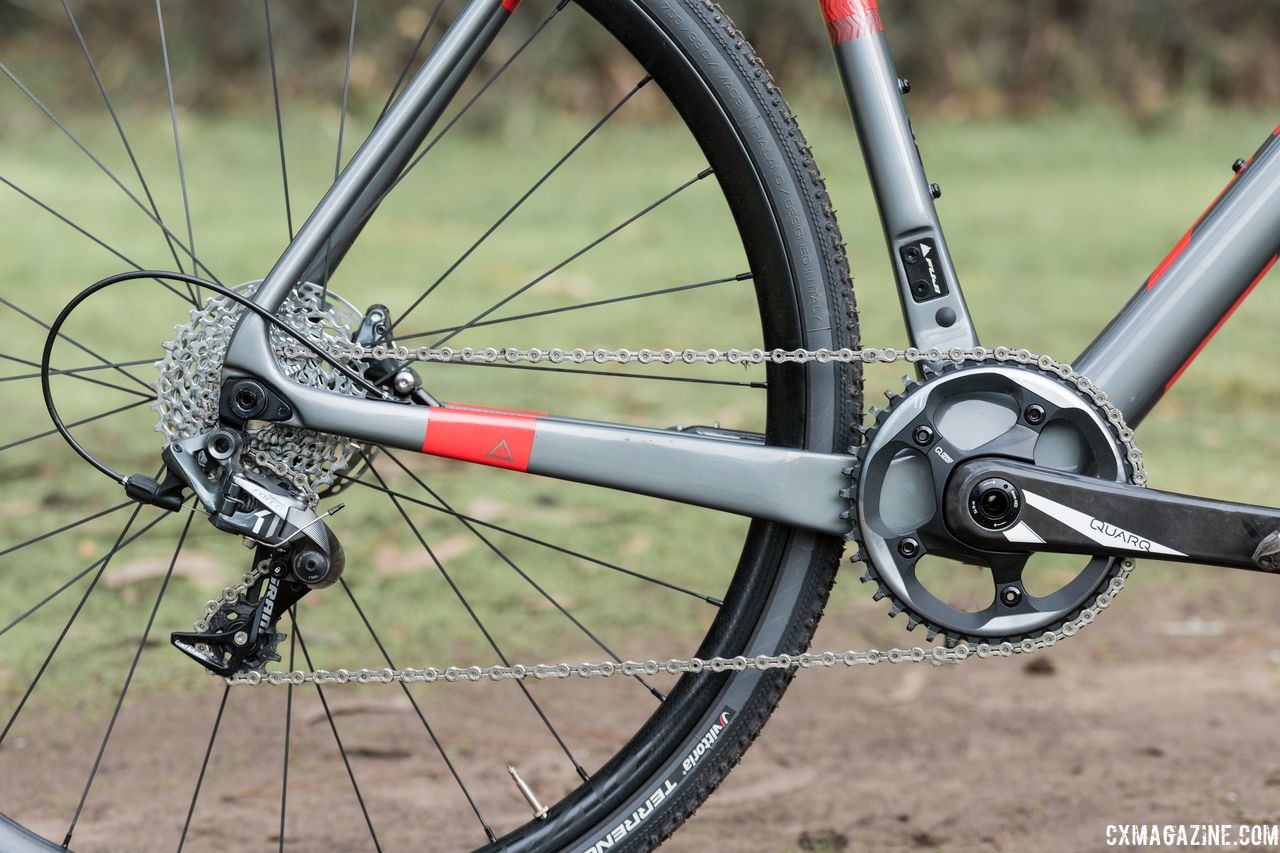
Our test bike came with race gearing that included a 42t front chain ring and 11-32t rear cassette. The crankset is a Quarq power-ready SRAM Force 1 crank. Fuji Altamira CX 1.1 carbon cyclocross bike. © C. Lee / Cyclocross Magazine
The wheelset is also from Oval Concepts. The Model 723 Disc is a 1,500 gram (claimed) wheelset with a 23mm-deep tubeless-ready aluminum rim. The internal width of the rim is 19mm. Spoke lacing is 2x with straight-pull, bladed spokes with external nipples. There are 24 spokes up front and 28 on the rear. The Oval Concept hubs have CenterLock rotors, and Vittoria Terreno Mix tubeless-ready tires with tubes installed came with the bike.
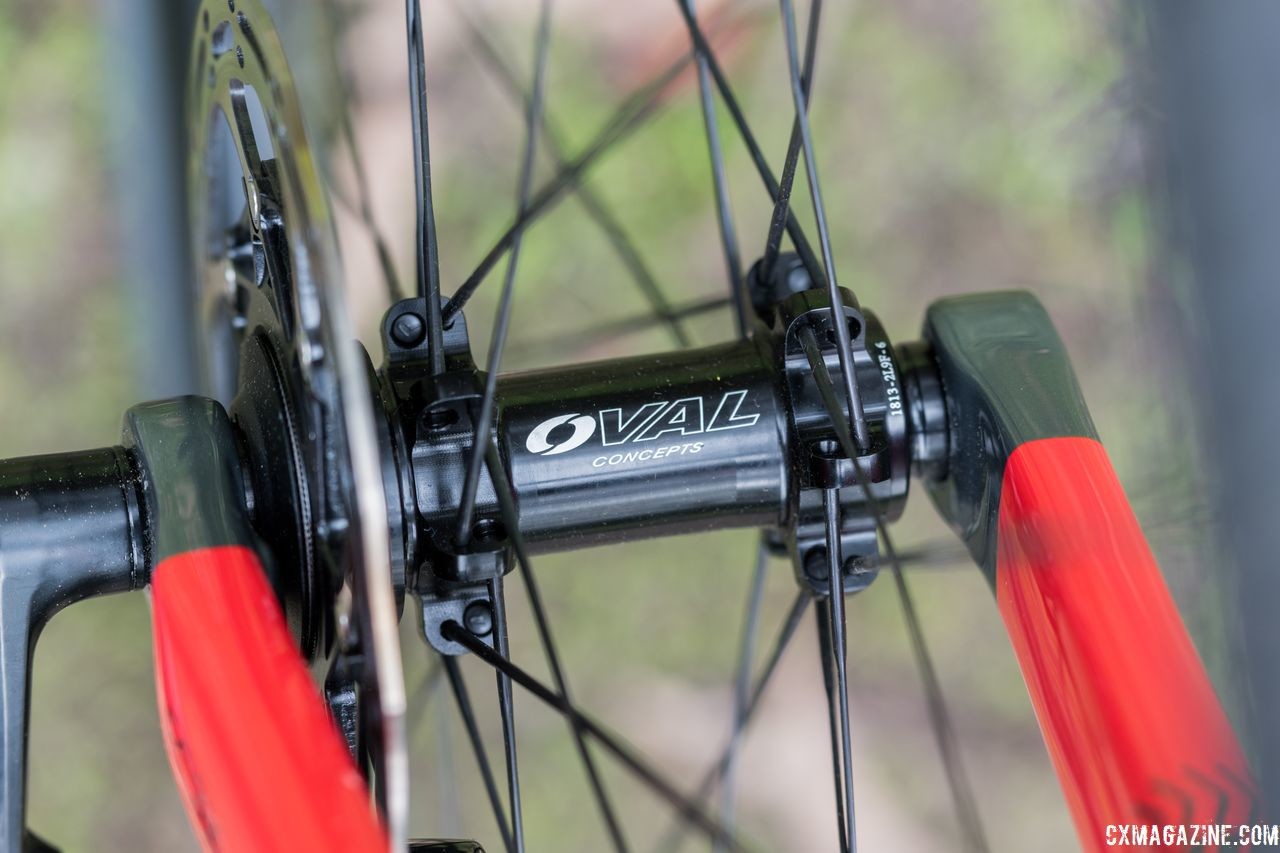
The Oval Concepts 723 Disc wheels come built with in-house hubs. Fuji Altamira CX 1.1 carbon cyclocross bike. © C. Lee / Cyclocross Magazine
A few nice details are the KMC 11X SL chain, the rubbery, padded handlebar tape and the screw-expander bar plugs.
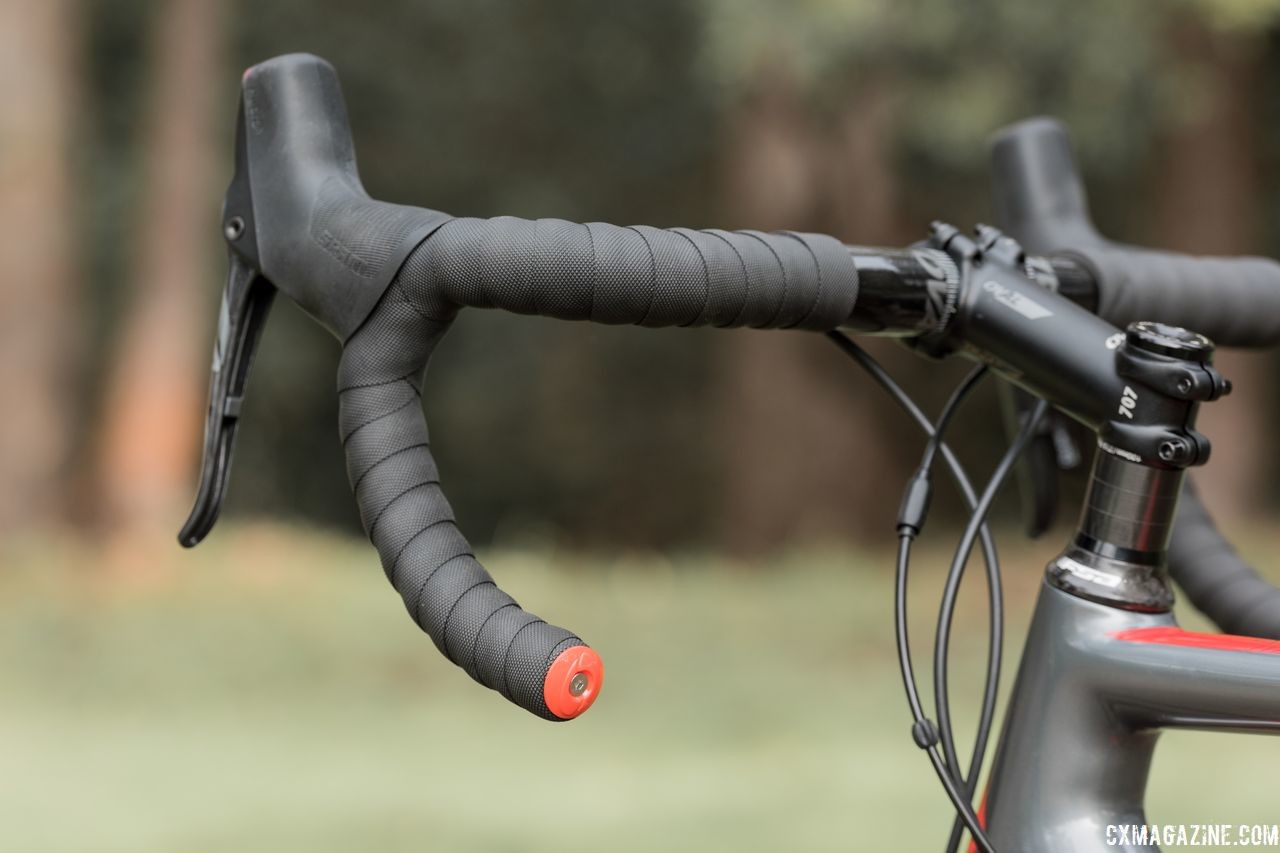
The screw-tight bar end caps are a nice, unexpected touch on the Altamira CX. Fuji Altamira CX 1.1 carbon cyclocross bike. © C. Lee / Cyclocross Magazine
The Fuji Altamira 1.1 CX weighed in at 17.2 pounds without pedals, which is undeniably light for a disc brake cyclocross bike.
The price of Fuji's top-end cyclocross bike is $4,000. That is certainly not cheap, but with the build and low weight, it certainly compares favorably to the cost of comparable bikes such as the Specialized CruX Expert, Trek Boone 7 Disc, Cannondale SuperX SE Force 1 and Kona Super Jake, among others.
The Ride
We received our Fuji Altamira CX 1.1 test bike during the recent cyclocross season, and I had ample opportunity to ride in both typical dry California conditions as well as some mudders thanks to the excess of rain we received during part of the season.
The carbon components and reasonably light wheelset contribute to a lively ride aided by the bike's low weight. There is no doubt that saving a pound (or more) in bike weight over another pays off when racing cyclocross. Cyclocross has a lot of accelerations (maybe more for me than an elite rider), and if you have to accelerate less mass, you save energy and go further faster.
The Altamira CX 1.1 felt efficient and fun to ride, and the svelte weight contributed to a ride that felt nimble and lively with the machine responding to pedal and handlebar inputs.
The weight is impressive, but I also immediately noticed the centimeter-plus increase in ground-to-saddle height when swinging a leg over. The added height is somewhat noticeable on remounts, but it really affected the ride when I had to dab, especially on technical downhills.
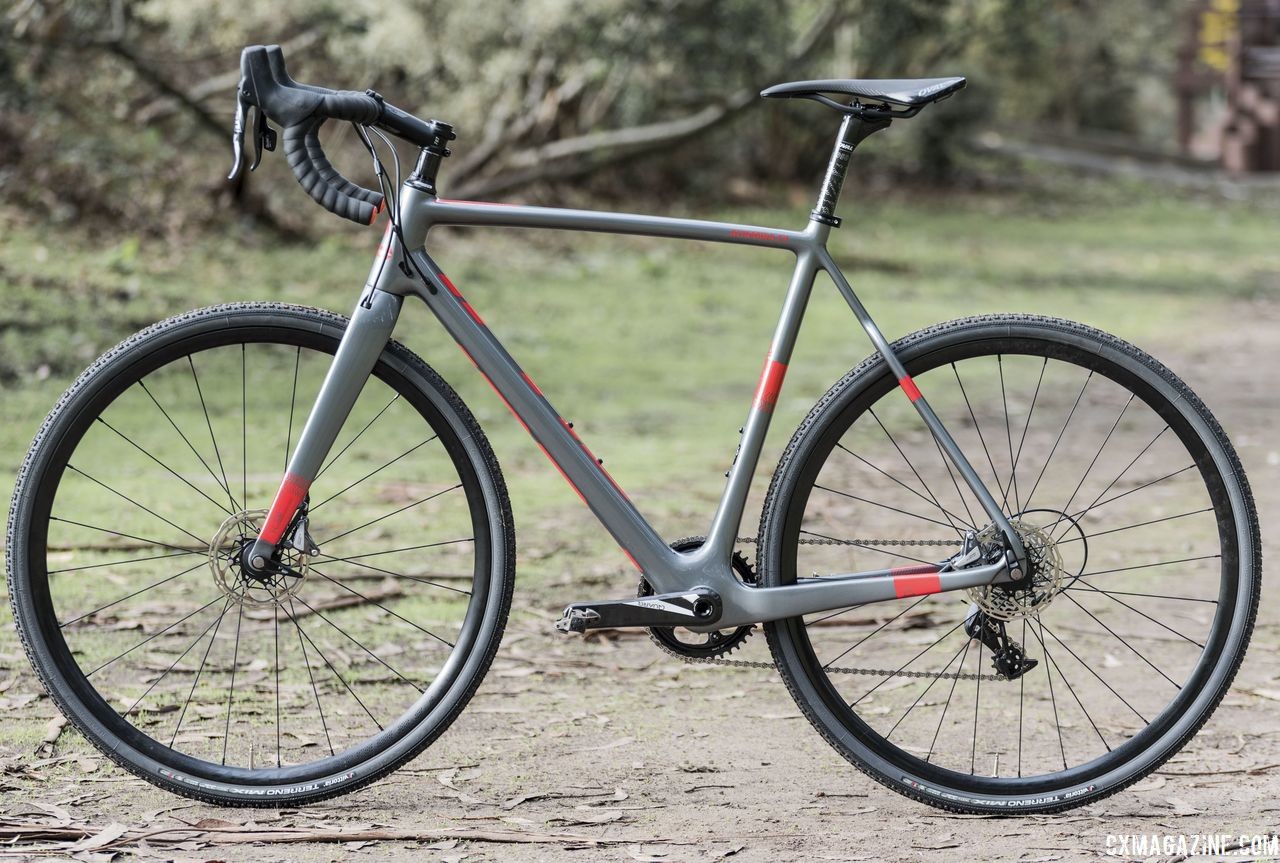
The bottom bracket is high on the Altamira CX by both modern and historical standards. Fuji Altamira CX 1.1 carbon cyclocross bike. © C. Lee / Cyclocross Magazine
That said, I was able to quickly adapt to the feel. The high bottom bracket showed its advantage on the cyclocross course in allowing me to pedal out of corners sooner, apply power over rooted sections or hit the gas over the crest of a steep rise without pedal strike. Those are all great feelings.
While the high bottom bracket helped roll over things, in sections with tight turns and chicanes, the Altamira CX was a bit slower to maneuver. While test riding the bike, I lowered my saddle a half centimeter to compromise since my local rides and races had elements where I felt a lower center of gravity would be beneficial. Such a setup technically sacrifices efficiency and is not quite the same as a lower bottom bracket, but it worked for me.
Perhaps a dropper post would have been cool on this bike, but that would remove the distinct advantage of lightness, especially since the substantial weight of a dropper post is up high.
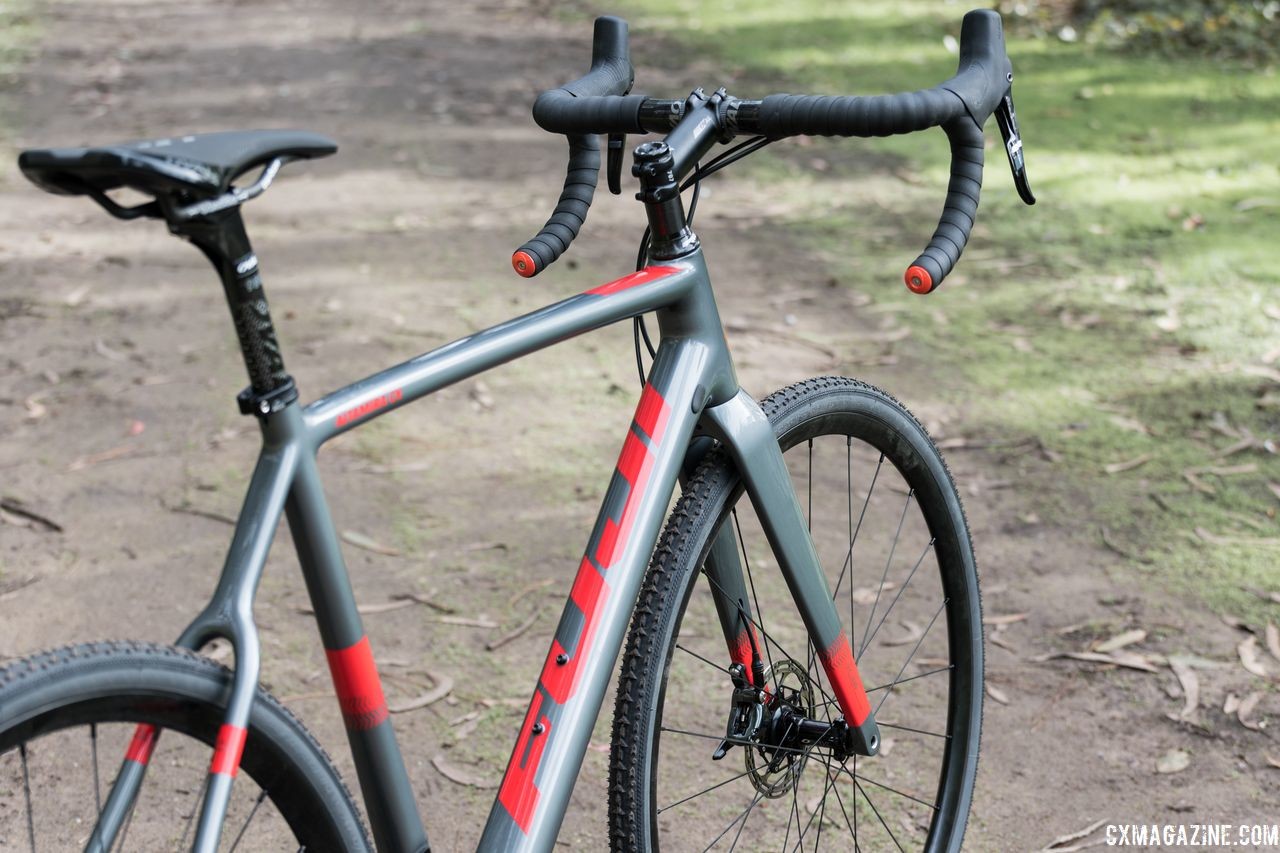
The author had to drop his seatpost a bit to get a comfortable ride. Fuji Altamira CX 1.1 carbon cyclocross bike. © C. Lee / Cyclocross Magazine
One remarkable quality of the Altamira CX is the ability to apply power over the rooted sections and bumpy grass while in the saddle. Now tire pressure plays a role in ride damping, but the heart of the bike-the frame-plays a significant role.
I’ve had the lucky opportunity to ride a lot of bikes of the same category over the same terrain with various tire and wheel combinations. I will tell you frame design absolutely plays a role in bike comfort, even if others might claim it does not.
I like a bike where I can stay more comfortably seated to apply power over bumpy sections. Staying seated allows better bike control and also reduces body and mental fatigue over the course of an hour-long race. The Altamira provides that kind of ride.
I already mentioned the feeling of efficiency, so the damping does not seem to affect power application, and in fact, it enhances it. The Altamira CX is not "flexy" or "whippy," something we rarely feel in a modern bike anyway. At the same time, it has none of the harshness that I’ve felt in many bikes recently.
I swapped between the included wheelset with the Vittoria Terreno Mix tires and a set with narrow Schwalbe X-One Bite mud tires. Tire clearance of the Altamira CX is for cyclocross tires, with the most limiting area at the chainstays. WTB Nanos—labeled at 40mm wide, measured at 39mm—did fit with minimal residual clearance.
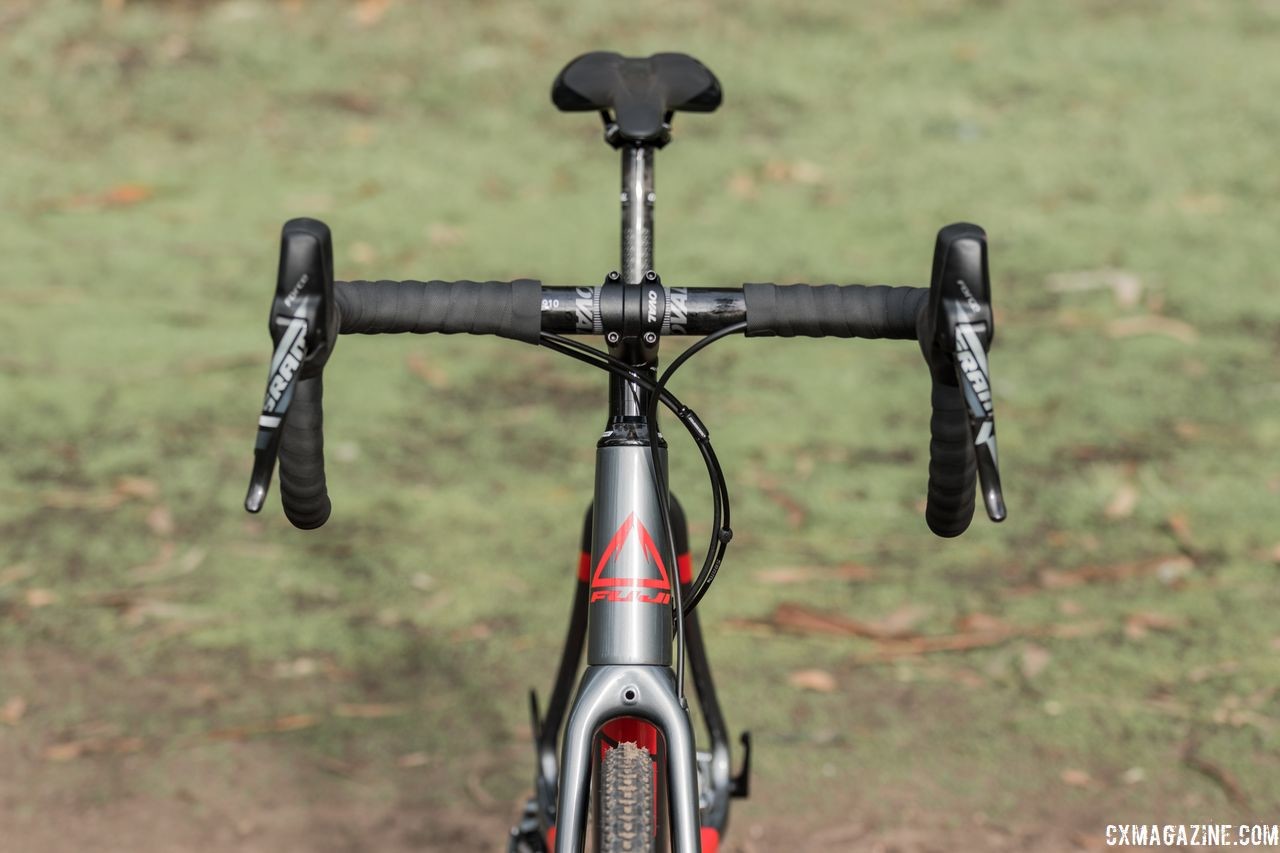
As a cyclocross race bike, the Altamira CX has narrow tire clearance front and rear. Fuji Altamira CX 1.1 carbon cyclocross bike. © C. Lee / Cyclocross Magazine
Generally speaking, any cyclocross bike will work as a gravel bike, but with the narrow tire clearance and high bottom bracket, the Altamira CX is not designed as a cyclocross / gravel crossover. The Altamira CX 1.1 feels racy, so I treated it like a race bike with the one concession of putting on a smaller chain ring for my non-professional legs and the hilly terrain where I reside.
The Verdict
The Altamira CX 1.1 is a turnkey cyclocross race bike. It is really light, nimble, efficient and offers some damping for speed. The included gears are appropriate for cyclocross, but that depends on your level and fitness.
The Fuji Altamira CX 1.1 follows the trend of cyclocross bikes becoming more race oriented. The Altamira has race pedigree in spades and offers a great platform that is really fun to ride if you love performance mixed terrain and cyclocross riding.
That said, with the cyclocross race focus of the bike, there are no provisions for gravel, bike packing or commuting. Additionally, the high bottom bracket and narrow tire clearance make it a bike best suited for ripping ’cross courses for an hour, not pedaling undiscovered roads for five or six. If you are looking for a gravel bike, we recently looked at the new Fuji Carbon Jari 1.1 gravel bike.
So who might like the Altamira CX 1.1 cyclocross bike? Weight weenies are likely to find its 17.2-pound full build up to their light standards, and cyclocross racers amateur and with the initials JP will like its handling and responsiveness between the tape.
The top-end Fuji Altamira CX 1.1 is priced based on its pedigree, so those on a budget might want to look at the Altamira CX 1.3, which comes with a SRAM Rival groupset and costs a grand less. The Altamira CX also comes up a bit narrow and high in chainstay clearance and BB drop, so it is not a bike for riders looking for a cyclogravel crossover or who like to ride high-volume cyclocross tires.
For more on the Fuji Altamira CX 1.1 we reviewed, see the specs and photo gallery below.
Fuji Altamira CX 1.1 Specs
MSRP: $4,000
Weight: 17.2 pounds, no pedals; 10.2 lbs without wheels or pedals
Frame: Fuji C10 high modulus Carbon Fiber, 12mm thru-axle, flat mount disc
Fork: Fuji FC 330 carbon, tapered carbon steerer 1 ¼"-1 1/8", 12mm thru-axle, flat mount disc
Shifters: SRAM Force 1 HRD Shift-Brake Levers, 11-speed
Brakes: SRAM Force HRD, flat mount disc
Rotors: SRAM Centerline, 140mm front and rear
Crankset: SRAM Force 1, Quarq power-ready, 42t X-Sync chain ring
Rear Derailleur: SRAM Force 1, 11-speed
Cassette: SRAM PG-1070, 11-32t
Cockpit: Oval Concepts 910 Ergo carbon bar and 707 aluminum stem
Seatpost: Oval Concepts 950 carbon, two-bolt
Saddle: Oval Concepts X38c
Wheels: Oval Concepts 723 Disc alloy tubeless clinchers, 19mm internal width, CenterLock hubs
Tires: Vittoria Terreno Mix, tubeless, 700c x 33mm
Warranty: limited lifetime, defects in materials and workmanship
Country of origin: Taiwan
More Info: fujibikes.com











